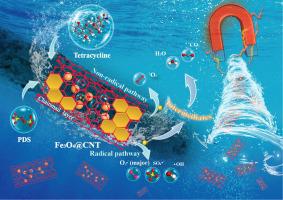Separation and Purification Technology ( IF 8.1 ) Pub Date : 2021-05-07 , DOI: 10.1016/j.seppur.2021.118705 Biming Liu , Wenbin Song , Wenwen Zhang , Xiao Zhang , Shunlong Pan , Haixia Wu , Yongjun Sun , Yanhua Xu

|
Confining metal oxide nanoparticles (NPs) in carriers such as carbon nanotubes (CNTs) has become a novel strategy for designing highly efficient and stable non-noble metal chainmail catalysts. In this study, Fe3O4 NPs were confined in the chainmail of multi-walled CNTs to prepare Fe3O4@CNT magnetic nanocomposite with confinement effect, and peroxydisulfate (PDS) was activated to degrade tetracycline (TL) in aqueous solution. Under the conditions of 20 °C, pH0 = 7, 0.5 mM PDS and 0.4 g/L Fe3O4@CNT, TL degradation efficiency of 98.1% could be achieved by radicals ( OH, SO4
OH, SO4 −, O2
−, O2 −) and non-radicals (1O2) generated in the system. Stable carbon-layer structure can protect Fe3O4 NPs inside the chainmail from the influence of reaction environment. TL degradation efficiency still reached 80.2% after five cycles, and the leaching of Fe ions was less than 10 μg/L during each cycle. Electrochemical analysis and density functional theory (DFT) calculations show that electron transfer from active Fe3O4 NPs to the carbon layer to motivate the catalytic activity of carbon surface. This work will provide an innovative path for the application of chainmail catalysts in nano-water environmental remediation.
−) and non-radicals (1O2) generated in the system. Stable carbon-layer structure can protect Fe3O4 NPs inside the chainmail from the influence of reaction environment. TL degradation efficiency still reached 80.2% after five cycles, and the leaching of Fe ions was less than 10 μg/L during each cycle. Electrochemical analysis and density functional theory (DFT) calculations show that electron transfer from active Fe3O4 NPs to the carbon layer to motivate the catalytic activity of carbon surface. This work will provide an innovative path for the application of chainmail catalysts in nano-water environmental remediation.
中文翻译:

Fe 3 O 4 @CNT作为高效,稳定的链邮催化剂,用于过氧二硫酸盐活化的四环素降解:性能和机理
将金属氧化物纳米颗粒(NPs)限制在诸如碳纳米管(CNTs)之类的载体中已成为设计高效,稳定的非贵金属链条催化剂的一种新策略。本研究中,将Fe 3 O 4 NPs限制在多壁碳纳米管的链状中,以制备具有约束作用的Fe 3 O 4 @CNT磁性纳米复合材料,并活化过氧二硫酸盐(PDS)降解水溶液中的四环素(TL)。下的20℃,pH值的条件0 = 7,0.5mM的PDS和0.4g / L的Fe 3 ö 4 @CNT,98.1%TL降解效率可以通过自由基(实现 OH,SO 4
OH,SO 4  -,O- 2
-,O- 2  -)和系统中生成的非自由基(1 O 2)。稳定的碳层结构可以保护链邮内部的Fe 3 O 4 NP不受反应环境的影响。在五个循环后,TL的降解效率仍达到80.2%,并且在每个循环中,Fe离子的浸出量均小于10μg/ L。电化学分析和密度泛函理论(DFT)计算表明,电子从活性Fe 3 O 4 NPs转移至碳层,从而激发了碳表面的催化活性。这项工作将为链邮催化剂在纳米水环境修复中的应用提供一条创新途径。
-)和系统中生成的非自由基(1 O 2)。稳定的碳层结构可以保护链邮内部的Fe 3 O 4 NP不受反应环境的影响。在五个循环后,TL的降解效率仍达到80.2%,并且在每个循环中,Fe离子的浸出量均小于10μg/ L。电化学分析和密度泛函理论(DFT)计算表明,电子从活性Fe 3 O 4 NPs转移至碳层,从而激发了碳表面的催化活性。这项工作将为链邮催化剂在纳米水环境修复中的应用提供一条创新途径。











































 京公网安备 11010802027423号
京公网安备 11010802027423号